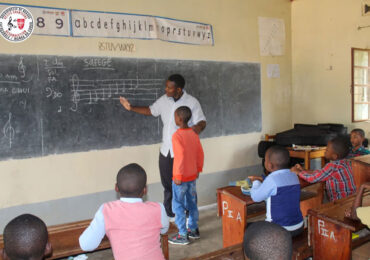Our twenty-month-old grandson was born 153 years after the birth of my grandfather.
The term ‘Catholic education’ means different things to different people. For the majority of us in this country Catholic education refers to the parochial school system which in 1884 the U.S. bishops mandated, in their third plenary session in Baltimore, be instituted in all parishes, namely one parish, one school. My grandfather was a young man then. The promotion of parochial schools flourished for the next 60 years and in the 1950s culminated in what many consider to be the “golden age” of Catholic education. Today many wonder if Catholic schools have a future. My grandson is a boy now and I too ponder what opportunities will there be for him for a “Catholic education.”
What prompts this reflection is this week’s celebration around the nation of Catholic Schools Week. The plenary session of the bishops meeting in Baltimore that formalized the parochial school system was held only 130 years ago when my grandfather was already a young man. In the grand scheme of things that wasn’t so long ago. One could suggest, therefore, that while many claim the ‘golden age’ of Catholic education is behind us, one could just as well suggest that Catholic education in this country is a young and vibrant force still in its formative years . No doubt it will take on new forms of delivery, but in its metamorphosed state it may well play an increasingly critical role in the ongoing development of our society.
What reasons could there be for this hope? Here are a few.
“We educate not because our students are Catholic but because we are Catholic.” This now famous dictum attributed to various sources, including Cardinal James Hickey of Washington, captures the core impetus of Catholic education: to bring any and all to a fuller realization of their dignity as human beings. In a world where human dignity is more and more ignored, this central purpose of Catholic education is increasingly important and appreciated by many, including non-Catholics.
Catholic education – especially in inner-city schools (see Pathways to Excellence in New York or the Independence Missions School movement in Philadelphia) – respect religious distinction among students and their families without compromising its own beliefs. Like St. Irenaeus, it posits “the glory of God is man fully alive” and so concentrates on the development of the whole person, including that person’s awareness of truth and virtue. This is evangelization that removes rather than erects the barriers that frustrate community and solidarity.
Much has been written about the cost effectiveness and superior quality provided by Catholic schools. From a societal point of view these are significant points to be sure. But, there is a more metaphysical reason for this hope for the future of Catholic education.
Whether recognized or not, respected or not, there is a force outside of us and within us that holds everything together. The classical purpose of education is to lead us outside of ourselves (e out + ducere to lead) towards a greater understanding of this force. Much of public education today is utilitarian and agnostic toward the existence of this force. It focuses the attention of the students on themselves and allows them to ignore this force or to decide what it should be. Catholic education recognizes the force as a reality and encourages its students to discern what it is. Some decide, some discern.
The difference between “deciding” and “discerning” has become so enormous in our society there is a disconnect. Were Catholic education – which underpins Western civilization and champions human dignity – to disappear the resurgence of barbarism would halt the advance of the Kingdom.


Having been involved in Catholic education since i was 10 years old, I found this article very articulate, very focused and very much to the point. I was a student, then had 5 children go through Catholic schools (K to 12), and then fundraised for a dozen catholic schools over 20 years. What is often missing in the entire Catholic education marketing, PR and message in general is the “raison d’etre.” It cannot be explained in less taxes, better grades, nicer safe atmosphere and all that. Those are not compelling reasons for any real commitment to Catholic education. Thankfully your article attempts to get to the heart of the matter and what matters. Catholic hospitals have the same issue. I will use them because of the life preserving and enhancing values they espouse, not becuase they are the best equipped, staffed, or have nicest facilities. Who cares if Catholic are in healthcare if not for the “life” centered values at the core of their ministry? The $1,000 suits running Catholic healthcare often lose sight of that fact. It is why so many nuns got out of the business – it is just business now and NOT God’s or the Church’s business first and foremost as it should be. Thank you for your fine contribution to this important discussion of the real value and impact of Catholic education.
As an aggressive proponent of Catholic Education, I am afraid that you are missing a fundamental point. Catholic resources are limited. Cardinal Hickey spent millions of dollars in Washington DC on the inner city schools educating non-Catholics with minimal evangelization results, while not building Catholic parish schools in the suburbs for Catholic children.
The rule for “one parish, one school” must have disappeared since my generation came onto the scene. I live in a mostly rural county, and there is only one Catholic school for multiple parishes. What’s more, I think it only covers grades 1-8. Highschoolers are left to fend in public school or attend a Catholic high school in another county. When laws, such as in California, reach beyond hard-core curricula to mandate what social ethics children must be taught in public schools, access to educational alternatives is a priority for religious parents.